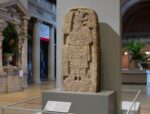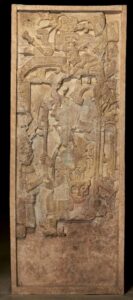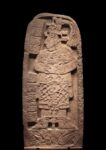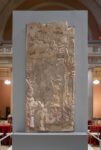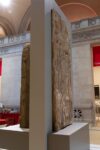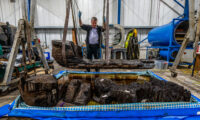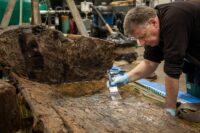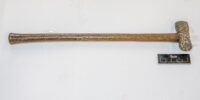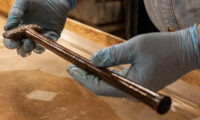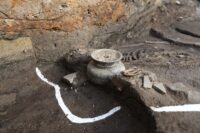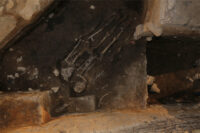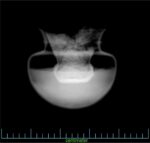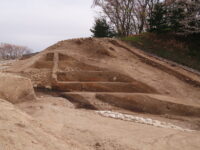 Archaeologists have unearthed an iron axe and machete dating to the Byzantine era in the ancient city of Assos in northwestern Turkey. The team found the tools while excavating the remains of dwellings which contained numerous daily use items like pottery and a small iron grill.
Archaeologists have unearthed an iron axe and machete dating to the Byzantine era in the ancient city of Assos in northwestern Turkey. The team found the tools while excavating the remains of dwellings which contained numerous daily use items like pottery and a small iron grill.
Excavation leader Professor Nurettin Arslan:
“One of the iron objects we found this year is a large iron knife, which we believe is a machete. It was found in Byzantine structures that we call the gymnasium (the training ground for athletes). The second one is an ax-type material that assumingly was used specifically for shaping and chopping wood. Both tools are quite important in terms of preserving their form well despite the long years that they have spent underground. They constitute an important example for the materials used in production in Assos.”

The axe and machete are largely intact, missing only organic parts like the handles. They stand out from the other objects recovered from the Byzantine layers as they are mostly pottery and found in fragments that the archaeologists have to piece together. The pots were used for cooking food — boiling grains and legumes, for example — as well as for serving it and storing it.
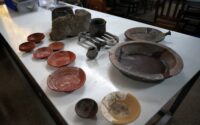 Founded on a hill overlooking the Aegean by colonists from the island of Lesbos around 1000 B.C., Assos had the only good natural harbour in 50 miles, so it was crucial to trade in the southern Biga Peninsula for thousands of years. It has been continuously populated since its founding. The name of the modern village is Behramkale, but Assos is still referred to by its ancient name in common parlance, and is a popular seaside resort town thanks to its picturesque Aegean location and extensive surviving ancient remains, which include a spectacular 6th century B.C. Doric temple of Athena on the crag overlooking the sea, the Hellenistic-era (6th-4th century B.C.) defensive walls and the dock which is still in use today.
Founded on a hill overlooking the Aegean by colonists from the island of Lesbos around 1000 B.C., Assos had the only good natural harbour in 50 miles, so it was crucial to trade in the southern Biga Peninsula for thousands of years. It has been continuously populated since its founding. The name of the modern village is Behramkale, but Assos is still referred to by its ancient name in common parlance, and is a popular seaside resort town thanks to its picturesque Aegean location and extensive surviving ancient remains, which include a spectacular 6th century B.C. Doric temple of Athena on the crag overlooking the sea, the Hellenistic-era (6th-4th century B.C.) defensive walls and the dock which is still in use today.
Its most famous resident was Aristotle who founded his first school of philosophy there in 348 B.C. after departing Athens and the Academy in the wake of Plato’s death. He lived there three years, a valued advisor of King Hermias and soon his son-in-law when he married the king’s daughter Pythias.
A quick word about Hermias who was a remarkable individual. He first appears on the historical record as a slave to a banker named Eubulus who became ruler of Assos and Atarneus when the Persian aristocrat who owned them used them as collateral for a loan and then defaulted. Hermias was a valued member of the household and as a youth was educated at Plato’s Academy which is where he first met and become fast friends with Aristotle. Eubulus died shortly after Hermias’ return to Atarneus, leaving Hermias as his successor.
Philip II of Macedon saw an opportunity in the new despot of Assos and Atarneus. He wanted an alliance with Hermias to get access to that invaluable port for a future invasion of Asia Minor and Persia, so he dispatched Aristotle to grease the skids with Hermias. It worked. Hermias and Philip formed a diplomatic and military alliance.
The alliance did not work to Hermias’ advantage in the end. Indeed, it led directly to his agonizing death. When Artaxerxes III of Persia began eyeing an invasion of Asia Minor to reclaim lost territories, the Greeks got nervous. Athens told Philip that if he even looked at Asia Minor funny, they’d join the Persians against him. Philip decided discretion was the better part of valour and withdrew his military support, abandoning Hermias to his fate.
Artaxerxes hired the Greek mercenary general Mentor to capture Hermias. Aristotle, horrified that Philip had abandoned his friend, frantically wrote to Mentor hoping to get him to switch sides. His arguments fell on deaf ears. Hermias was imprisoned and sent to Susa where he was tortured to extract information about Philip’s invasion plans. Hermias, who definitely had the goods on Philip, refused to talk. He was loyal to the end, even to the disloyal Philip, and died in 341 B.C. His last words were “tell my friends that I have done nothing shameful or unworthy of philosophy.”
Aristotle felt the loss keenly. He dedicated a memorial monument at Delphi to Hermias and wrote a hymn honoring his steadfastness in the face of betrayal.
And now for you Atarneus’ pride,
Trusting in others’ faith, has nobly died;
But yet his name
Shall never die, the Muses’ holy train
Shall bear him to the skies with deathless fame,
Honouring Zeus, the hospitable god,
And honest hearts, proved friendship’s blest abode.
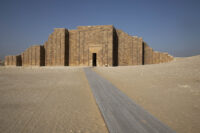 A monumental tomb across from the Step Pyramid of Djoser has reopened to visitors after 15 years of renovations. The Southern Tomb is part of the expansive mortuary complex built by Djoser’s royal architect Imhotep in Saqqara, a necropolis just outside the ancient Egyptian capital of Memphis. Built between 2667 and 2648 B.C., the Southern Tomb is a mastaba, a rectangular tomb with a flat roof (the step pyramid was made by stacking six mastabas on top of each other).
A monumental tomb across from the Step Pyramid of Djoser has reopened to visitors after 15 years of renovations. The Southern Tomb is part of the expansive mortuary complex built by Djoser’s royal architect Imhotep in Saqqara, a necropolis just outside the ancient Egyptian capital of Memphis. Built between 2667 and 2648 B.C., the Southern Tomb is a mastaba, a rectangular tomb with a flat roof (the step pyramid was made by stacking six mastabas on top of each other).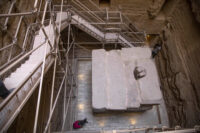 The limestone building you see on the surface is the figurative tip of the iceberg. Underneath the visible tomb is a labyrinthine warren of passages cut down into the living rock 100 feet below the surface. The long corridors are punctuated by false doors engraved with the hieroglyphics and inlaid with tiles of blue faience. At the base of the central funeral shaft is a massive pink granite sarcophagus, a smaller version of the one inside the burial room of the step pyramid.
The limestone building you see on the surface is the figurative tip of the iceberg. Underneath the visible tomb is a labyrinthine warren of passages cut down into the living rock 100 feet below the surface. The long corridors are punctuated by false doors engraved with the hieroglyphics and inlaid with tiles of blue faience. At the base of the central funeral shaft is a massive pink granite sarcophagus, a smaller version of the one inside the burial room of the step pyramid.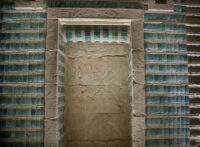 It’s not certain what the purpose of the tomb was. Djoser’s body was buried in his glorious pyramid. It may have had an unknown symbolic purpose. Mostafa Waziri, secretary-general of Egypt’s Supreme Council of Antiquities, hypothesizes that it was the most glamorous and expensive canopic jar ever, a great monument built to contain his internal organs.
It’s not certain what the purpose of the tomb was. Djoser’s body was buried in his glorious pyramid. It may have had an unknown symbolic purpose. Mostafa Waziri, secretary-general of Egypt’s Supreme Council of Antiquities, hypothesizes that it was the most glamorous and expensive canopic jar ever, a great monument built to contain his internal organs.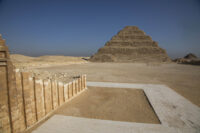 Restoration of the Southern Tomb began in 2006, part of the same comprehensive research and restoration of the necropolis that also shored up the dangerously precarious Step Pyramid, which reopened to visitors last year. The corridors, walls and ceilings under the mastaba were stabilized and new flooring and lighting installed. The granite sarcophagus was also recomposed.
Restoration of the Southern Tomb began in 2006, part of the same comprehensive research and restoration of the necropolis that also shored up the dangerously precarious Step Pyramid, which reopened to visitors last year. The corridors, walls and ceilings under the mastaba were stabilized and new flooring and lighting installed. The granite sarcophagus was also recomposed.


